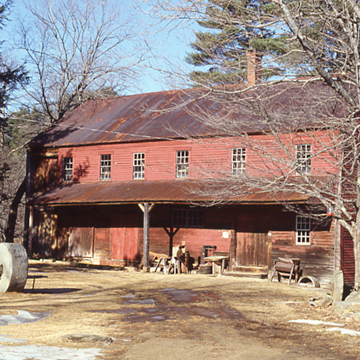You are here
Little River Grist Mill
Built on the eve of the American Revolution, the Old Grist Mill attests to the early importance of water power in colonial industry. It also attests to the craftsmanship and durability of colonial building; not only is the mill well-preserved, it remains a working mill, in addition to operating as a museum and meeting facility. The Little River Grist Mill is the oldest surviving industrial building in Lebanon, a town that was part of Massachusetts at the time of its construction.
The Lebanon mill, built along the Salmon Falls River in 1774, not only served as a grist or flour mill, but also as a clapboard mill and general woodworking shop. Built by Joseph Hardison, the mill (which survived the devastating spring flood of 1785) ground local grains until the arrival of the railroad in 1870, when it began to process Midwestern grains. The mill also housed a small store, and informally served as a village center, public meeting place, and later, as the town’s first gasoline station.
A large, two-and-a-half-story rectangular building, the Old Grist Mill features a gable roof and a small shed-like rear addition. It has massive, dry-laid stone foundation walls, five feet thick at the bottom and tapering to a width of two feet under the sills. At the rear of the mill, the foundation walls lie directly next to the stream. In the late nineteenth century, the center section of the mill’s foundation was replaced with concrete.
Typical of the period, the mill is framed with heavy, hand-hewn timber, 13 x 13 feet and up to 22 feet in length. The well-worn hardwood flooring is double thickness. Small, 6-over-6 sash windows are simply framed. A small chimney (without a foundation) sits off to one side away from the machinery. A porch extends along the front of the 6-bay building. Although some modest additions have been made to accommodate the small store and woodworking shop, the building preserves its external appearance. In 1993, the mill underwent a major restoration. Currently, the Old Mill functions as a museum open to the public and as a shingle manufacturing facility.
References
Jones, Samuel W. History of Lebanon, Maine. Unpublished manuscript, 1873. Maine Historical Society, Portland, Maine.
Shettleworth, Earle G. Jr., and Frank A.Beard, “Old Grist Mill,” York County, Maine. National Register of Historic Places Inventory-Nomination Form, 1975. National Park Service, U.S. Department of Interior, Washington, D.C.
Writing Credits
If SAH Archipedia has been useful to you, please consider supporting it.
SAH Archipedia tells the story of the United States through its buildings, landscapes, and cities. This freely available resource empowers the public with authoritative knowledge that deepens their understanding and appreciation of the built environment. But the Society of Architectural Historians, which created SAH Archipedia with University of Virginia Press, needs your support to maintain the high-caliber research, writing, photography, cartography, editing, design, and programming that make SAH Archipedia a trusted online resource available to all who value the history of place, heritage tourism, and learning.




















